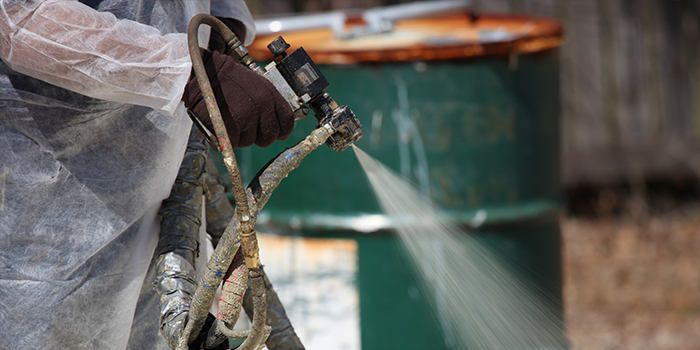Spray Guns

Back to Education Center | Equipment Guide
Spray Guns
Spray guns are precisely engineered pieces of equipment that perform the most critical functions of the SPF application process: mixing the chemical components and spraying it to the target substrate. The vast majority of polyurethane foam spray guns on the market use impingement-mixing technology to combine the chemicals inside the gun. When the trigger is pulled, equal amounts of the two chemical components enter the mixing chamber, where they begin to react. Because the fluid is under pressure, the mixture is immediately forced out of the chamber through a small orifice, thereby atomizing into a spray as it exits the gun.
It is important to understand that if the all of the reacted material is not expelled from the gun once the trigger is released, the material will start to cure and harden inside the gun, rendering it unusable. So, it is critical to completely remove, or purge, the gun of every particle of reacted material. There are three ways to do this, each representing a different class of spray gun: mechanical purge, air purge, and solvent purge.
Mechanical Purge
Mechanical purge serves two functions in a spray gun. A valving rod is set inside the mixing chamber of the gun. When the gun is not triggered, the valving rod remains static and blocks the two chemical ports. When the gun is triggered, the valving rod withdraws, opens up the two chemical ports to let the polyol resin and isocyanate materials into the mixing chamber. When the trigger is released, the rod comes forward to close off the two chemical ports and in doing so, purges the remaining mixed material out of the gun.
Air Purge
Air purge guns remove material from mixing chamber and gun block with a quick blast of air. In air purge guns, the mixing chamber itself moves back and forth as the trigger is pressed and released. When the trigger is pulled, the mixing chamber retracts, which opens up the fluid ports and allows the chemical components to enter the mixing chamber and exit the gun as a spray. When the trigger is released, the mixing chamber moves forward, blocking the fluid ports and opening special ports that allow air to flow through the mixing chamber and blow away any present material.
Solvent Purge
Solvent purge is less common for spray foam applications than it is for coating applications. Solvent purge spray guns flush a cleaning solvent through the gun to neutralize the chemical reaction and then wash out the inside of the gun. This isn’t favorable due to the fact that solvents can add extra costs in terms of purchasing and disposal, and they can be harmful to the operators and the environment.





























